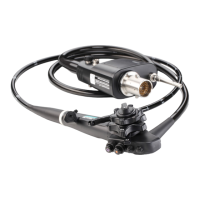64
Directions for use
4
4-3. Using an endoscopic device
Warning
• NEVER use a endoscopic device that displays signs of damage and/or operational abnormality.
Doing so may result in endoscope malfunction or damage and/or patient injury.
• All reusable endoscopic devices must be cleaned and sterilized before initial use, as well as
before every subsequent use.
• Before using the endoscopic device, check its compatibility with the endoscope, and read
and understand the respective IFU of the endoscopic device. Incorrect use of an endoscopic
device may result in damage to the endoscopic device and patient injury.
• Constantly check the endoscopic image while cautiously inserting and withdrawing the
endoscopic device.
• Ensure that the distal tip of the endoscopic device is adequately projecting from the distal end
of the endoscope before operating it. Failure to do so may result in damage to the instrument
channel and /or falling of the broken instrument channel particle(s) inside the patient’s body
cavity.
• After the endoscopic device is inserted into the inlet seal, NEVER let it hang down. Ensure
that the endoscopic device is supported with a hand and no load is applied to the inlet seal.
Failure to do so may result in lowered suction function as well as potential reflux or dispersal
of patient’s body fluids, posing a risk of infection to the user.
• Use only compatible endoscopic devices specified by PENTAX Medical. Using non -
compatible endoscopic devices NOT specified by PENTAX Medical may result in clogging
and /or damage to the instrument channel and /or endoscopic device. If a liquid such as
sterile water or physiological saline is injected with a syringe into the instrument channel inlet
while the instrument channel is clogged, the suction control valve may detach, resulting in
the potential dispersal of patient fluids into the environment, and posing a potential risk of
infection to the user.
• Immediately stop the endoscopic procedure if the endoscopic device can NOT be withdrawn
from the endoscope. Do NOT attempt to forcefully withdraw the endoscopic device. Slowly
and cautiously withdraw the endoscope in which the endoscopic device is inserted. Failure
to do so may result in damage to the endoscopic device and /or instrument channel, as well
as the potential dispersal of patient fluids into the environment, posing a risk of infection to
the user.
Caution
• When inserting or withdrawing the endoscopic device, ensure that its distal tip is closed or
retracted within the sheath. Straighten the endoscopic device and slowly withdraw it. Failure
to do so may result in inlet seal damage and/or falling of the broken inlet seal particle(s) into
the patient’s body cavity.
• Do NOT forcefully insert the endoscopic device when the instrument channel is clogged, as
this may result in damage to the endoscope.
• Keep the endoscope bending section as straight as possible when inserting and withdrawing
an endoscopic device. Forcefully inserting and withdrawing an endoscopic device may result
in damage to the instrument channel and endoscopic device and/or patient injury.

